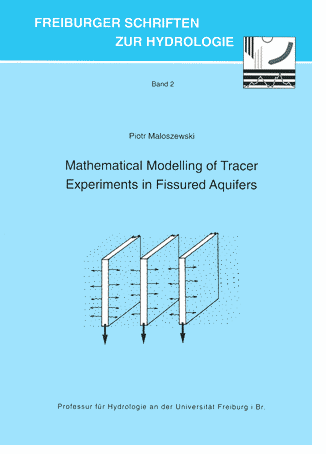|

Freiburger Schriften zur Hydrologie
 |
[ << Band/volume 1 ] [
Freiburger Schriften zur Hydrologie ] [
>> Band/volume 3 ]

Band/volume 2: MALOSZEWSKI P. (1994):
Mathematical Modelling of Tracer Experiments in Fissured Aquifers
 Models of solute transport in fissured rocks applicable for the interpretation
of tracer experiments are discussed in detail. All the models derive from
the Parallel Fissure Dispersion Model (PFDM), which couples the transport
equation in fissures with the diffusion equation in matrix. In short-term
tracer experiments its approximation, i.e. the Single Fissure Dispersion
Model (SFDM), or the Single Fissure Piston Flow Model (SFPFM), are shown
to be applicable.
Models of solute transport in fissured rocks applicable for the interpretation
of tracer experiments are discussed in detail. All the models derive from
the Parallel Fissure Dispersion Model (PFDM), which couples the transport
equation in fissures with the diffusion equation in matrix. In short-term
tracer experiments its approximation, i.e. the Single Fissure Dispersion
Model (SFDM), or the Single Fissure Piston Flow Model (SFPFM), are shown
to be applicable.
For long-term tracer experiments and for the interpretation of environmental
tracer data, the common Dispersion Model (DM) with parameters governed
by matrix diffusion is shown to be adequate. Other models applicable to
the dating of old waters are obtaihed from steady and transient states
solutions to the basic model, i.e. the PFDM. The influence of parameters
on the tracer curves yielded by particular models is investigated theoretically
and demonstrated graphically by making use of direct solutions.
Case studies show how the inverse problem can be solved, i.e. how some
parameters of an investigated system can be found by calibration (fitting)
of the model to the experimental data. It is shown, that a good fit is
a necessary but not sufficient condition for the applicability of a model.
Validation, or a partial validation at least, should be obtained wherever
possible.
Conditions for the applicability of the approximate models have beerl
derived and their usefulness demonstrated. In all field case studies interpreted
so far by the author, the matrix diffusion was shown to playadominant
or important role.
The mean transit time of water obtained from the 14C or tritium ages,
interpreted without taking into ac count the retardation factor resulting
from the matrix diffusion, is shown to lead to greatly overestimated volumes
of mobile water in fissured systems. Artificial tracer experiments, designed
for finding the retardation factor caused by matrix diffusion and possible
reactions, are shown to be potentially useful for the interpretation of
environmental tracer data. On ce the retardation factor is known, it can
be used to interpret the mobile water content and/or other hydrogeological
parameters from the environmental tracer ages. However, the concept of
the retardation factor, which is weIl defined for conservative tracers,
is not generally applicable for relating the environmental radiotracer
ages with hydrogeological parameters. Its applicability has to be examinated
for each case study.
It has also been demonstrated, that the parameters of the common dispersion
model (DM) cannot be obtained from short-term tracer experiments, even
if a good fit of that model is obtained. However, the SFDM applied to
short-term experiments can be used to determine the physical parameters
of the system, which can in turn serve for obtaining the parameters of
the DM, applicable at large scales, and then for the prediction of pollutant
movement.
[ deutsche Zusammenfassung ]
PDF-Download (3,3 MB)
|

